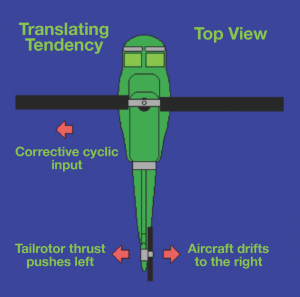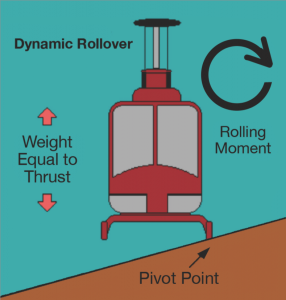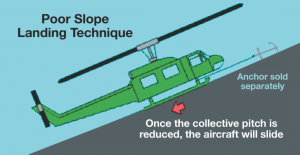Helicopter CK again
Welcome back to another session of Helicopter CK.
I will assume you are reading this because you enjoyed the previous session on Helicopter CK and have returned to satiate your craving for more helicopter CK, or you just have no one to talk to right now, and figure this might be as good a time as any to learn some more stuff about helicopters. In either case, thanks for spending part of your day with me; I appreciate it. And to reward you for stopping by, today’s lesson is full of some really cool helicopter cocktail knowledge (CK) so that when you do have someone to talk to, you can impress the heck out of them.
So, if you attended our last session, among other nuggets of CK, you learned about the difference between the Brayton and Otto cycle, why helicopter pilots sit mostly in the right seat, and of course that sure-fire conversation starter, dissymmetry of lift. Today, in keeping with our tradition of education and entertainment, we shall begin with the term “left skid low.”
Helicopter Translating Tendency
So what does “left skid low” or for the French helicopter pilots “patin droit bas” (right skid low) have to do with a helicopter’s translating tendency? Well for sure, you will see it has nothing to do with the helicopter being bilingual. Nope, helicopter translating tendency is a normal occurrence with hovering helicopters.
The textbook definition for this flight behavior is: The tendency or inclination of a single rotor helicopter to drift laterally. And why will the helicopter drift laterally you ask? Because of the thrust produced by the tail rotor, that’s why.
Is there really that much tail rotor thrust? You betch’ya there is. Remember that the tail rotor has a 6 to 1 rotational ratio to the main rotor, meaning it is spinning 6 times faster than the main rotor. The tail rotor has to spin this fast because, as you long time students know, the job of the tail rotor is to compensate for the torque of the main rotor, and by doing its job, our thrusting tail rotor tends to push the aircraft sideways at a hover. We compensate for this by adding left cyclic control inputs (on American helicopters, the opposite in the French-manufactured aircraft because their rotor systems turn the opposite way).
This makes the US-manufactured helicopter hang left skid, or wheel, low at a hover. If you ever see an American helicopter hovering, you may notice this left side low condition. If you ask a helicopter pilot how he is doing today, and he answers, “left skid low,” or because it is the opposite for the French pilots, “patin droit bas”, that means right now, all in his or her life is normal (or as normal as it can be for a helicopter pilot). So, the very next helicopter pilot you meet, ask them if they are “left skid low” or “patin droit bas” and they will be impressed; trust me.
Settling With Power
As shown in Figure 2, settling with power is very unsettling if you are in a helicopter that is experiencing this condition. Settling with power is a dangerous condition that any pilot may face which, if he or she is not focused, can cause a serious and uncontrollable situation. Now, just what is “settling with power”? When the helicopter settles into the rotor wash produced by its own main rotor system, that my faithful students, is settling with power.
Settling with power requires three key flight characteristics to take place in combination with one another:
1. a near zero airspeed
2. up to 100% power applied
3. a better than 300-foot-per-minute rate of descent
Once you have completed this triangle of disaster, the aircraft will settle in its own down wash from the rotor system. And in this case, you settle with all the finesse of a homesick rock. The only way to recover from this situation is to obtain forward airspeed and allow the rotor system to fly into “clean air.” After the rotor system is clear of the rotor-wash, it will become efficient again, and the settling with power conditions will cease to exist. This can become a real problem while flying in an out of ground effect hover (above 10 feet from the ground), and/or during landings.
OK, now for you US Navy types, the situation I have just described is known to you as power settling, and you army aviators out there, settling with power is what you call it. Confused? Just wait. To add more to the confusion of terms, the different branches of service have different meanings for the latter two terms.
The navy uses the term “settling with power” as a means to explain how high temperatures and high humidity will reduce the available power a helicopter can generate and use. The army uses the term “power settling” to describe the same phenomenon.
Say what? You would think these two branches of the US armed forces would get this cleared up. Now to add to the discussion, lets interject the term, “vortex ring state,” which describes the actual swirling of the air within the rotor system itself that causes settling with power (army) or power settling (navy). But these two branches of the US armed forces can’t even agree on when the vortex ring state begins.
The army manuals say that vortex ring state can begin to occur when you have 300 feet per minute (FPM) as a rate of descent. The navy says 800 FPM is a more accurate figure. Come on you guys, can’t we all just get along?
The bottom line, however, is that no matter which term you use to describe it, settling with power or power settling is a dangerous situation that any rotary wing aircraft can experience. Pilots need to be aware of the situation and avoid it at all cost. OK? What shall we describe next? How ‘bout another fun activity that is unique to helicopters called dynamic rollover?
Dynamic Rollover
A different and dangerous maneuver that a helicopter pilot can experience, and should avoid, is called dynamic rollover. What actually happens is that the helicopter, which by the by, is on the ground, will start to roll over on its side using one skid or wheel as the pivot point or fulcrum. As the helicopter begins to roll, the only thing that will stop the forces in action from flipping the aircraft on its side is a reduction of collective. This action reduces the thrust-to-weight ratio, which allows the aircraft to settle back down in a level attitude. However, if the helicopter is sitting sideward on a sloping terrain, as is depicted in Figure 3, a collective reduction performed too quickly can cause the aircraft to roll over on the other side, and down the hill it will go. So, as you can imagine, care and caution are essential when performing slope operations. But, should the pilot become complacent, a dynamic roll over can occur on the flattest of surfaces just as quickly.
And once again, just like settling with power (or for you naval aviators, power settling), three distinctive components are required for this precarious situation to happen:
1. a pivot point,
2. a rolling moment
3. weight equal to thrust at some time during the maneuver
Now, if landing sideways on a slope is dangerous, why not land from the front or back? Well, most helicopters have skid-type landing gear like a sled. Like that sled, the helicopter skid gear has no brake system, and once again like that sled, it will want to slide down a hill if the toes or heels of the skids are pointed up hill and the power holding the aircraft in place is taken away. Once power is reduced, the weight of the aircraft will get the sliding started, and it will stop only when it reaches the bottom of the hill. Unlike when you used a sled as a kid, this is not a fun ride.
Other reasons not to approach a slope from the front or back is that the tail boom may strike the hill before the skids do (again depending on the degree of the slope), or the rotor system may smack the hill before the skids reach the ground. For these reasons, helicopter drivers use a standard of eight degrees of incline as a maximum, allowing a sideward approach to the slope that will have the skids touching before the rotor system.
Here’s one other word of caution if you are a passenger exiting a helicopter that has landed on a hill. Unless you want a haircut beginning at the neck, exit on the downhill side of the running helicopter, and trust me the helicopter will be running. If you go up the hill you will experience that haircut I just described, as well as ruin a good set of expensive main rotor blades.
Also if you are going to call your local parts supply house for the anchor shown in Figure 4, forget it. A helicopter anchor for securing the helicopter on the hill is constructed from a rare material called unobtainium.
All right my friends, enough for today’s session. It’s time for you to go out and find somebody to impress with all the CK you have just learned. And remember, until next time, even the best pilot can’t fly ‘til you, the technician, says the aircraft is safe to fly.
About The Author
Mike Broderick is V.P. of Business Development at Helicopter Engine Repair Overhaul Services (HEROS). Over the past 35 years, he has served as a shop technician, engine shop supervisor, Engine Program Director, Director of Maintenance, Director of Operations, and owner of a Rolls-Royce engine overhaul and MD Helicopter component overhaul shop. He is a certified A&P, and holds a Bachelor of Science degree in Aviation Administration. As well, Mike has been appointed as an FAA representative for the FAA Safety Team (FAAST) and is a member of the HAI Tech Committee. Mike is a regular contributor to Air Maintenance Update.
View all articles by Mike Broderick.



















































